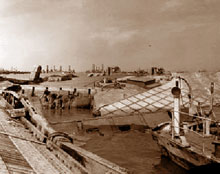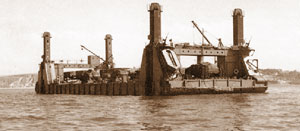Mulberry storm
After Mulberry storm

After the storm
On June 23 10.000 tons were unloaded at Omaha and shortly afterwards normal output was being achieved, though without the advantage of the piers. The gooseberries protected the other beaches. Utah, also being exposed to the west, lost two blockships and three others were in a poor state. Shipping tended to be diverted to Grandcamp and Isigny. After the gale, the commanders of the respective harbours inspected the damage. Mulberry A had undoubtedly suffered the greatest. Yet such was the spirit of the construction force that it believed that, despite the chaos, the port could be restored to working order. Ellsberg, an expert salvage officer, supported this view. But the Mulberries had always had their detractors. Apparently Commodore W. A. Sullivan, Supervisor of Salvage, US Navy Department was one of these. Moreover, he and Ellsberg had not, on a previous occasion, seen eye to eye. After a cursory inspection Sullivan reported to the senior naval commander, Admiral Kirk, that a salvage operation was impracticable. Kirk accepted his verdict, influenced by some of his staff who were scornful about the force of the gale, implying that the harbour itself was inadequate.
Eisenhower order: Abandon Mulberry A
Eisenhower therefore ruled that Mulberry A should be abandoned but that the Gooseberry should be reinforced with additional caissons and all the spare parts and salvage equipments would be reused to fill up the Mulberry B breaches. Apart from the first half of August, the weather continued to be uncertain right into the autumn. Fog and high winds were experienced late in July and another severe storm interrupted discharge of men and supplies on August 1st. Heavy seas pounded the coastline at the beginning and end of September so that strengthening of the Mulberry and the Gooseberries at Omaha and Utah assumed great importance. The new Phoenixes being built around the English coastline were awaited with impatience but the V weapon offensive, which began soon after D-Day, drew away a number of workmen for emergency repair of houses. American Army Engineers were called upon to build five large square-ended caissons at Grays and Tilbury. During the summer Omaha have been strengthened with a further ten Blockships and twenty-one caissons, but a gale on October 6 broke the backs of four of them and twelve Phoenixes were also destroyed. In spite of the bad weather, according to the Commander, US Ports and Bases, the Gooseberry continued to be of tremendous value. Ships had to be beached now that the piers had gone but it was discovered that the rock inshore was crumbly, almost to the consistency of sandstone. Bulldozers planed down these rugged surfaces thus enabling ships to ground on the beaches without damaging their hulls.

What about Utah
Utah also continued to discharge quantities of men, vehicles and supplies. On the last two days of July a record of 25.853 tons were unloaded at the two beaches. The target tonnage for the two beaches had recently been raised from 5.700 to 10.000 tons for Utah and from 10.500 to 15.000 tons for Omaha.
The flow of vehicles during that month continued unabated. An average of 3.283 per day was brought ashore but as the autumn advanced the tonnage began to decrease.
By October 1st it seemed unlikely that the rate of discharge would recover momentum. The weather was becoming increasingly difficult and the DUKWs, most of which had been operating since the early days of the landing, were showing signs of wear and tear.
Mulberry advocating
The senior commanders were at least grateful for the Mulberries. According to Eisenhower, «Mulberry exceeded our best hopes... average tonnage per day from 20 June to 1 September was 6.765 tons». Eisenhower's deputy, Air Chief Marshal Sir Arthur Tedder, acknowledged Churchill's persistence in advocating the Mulberries without which «that extraordinary operation might never have come to fruition. Indeed the whole question of the invasion of Europe might well have turned on the practicability of these artificial harbours». And although there is force in the detractors of Mulberry's arguments, they ignored, as Australian war correspondent and military historian, Chester Wilmot, has ably argued, important strategic and psychological factors. Strategically the «possession» of Mulberry gave the planners the freedom to choose a landing area away from the heavily fortified major ports; psychologically, it gave the Allied High Command a degree of confidence without which the venture, which seemed so hazardous, might never have been undertaken. Albert Speer, Reichsminister for Armament and War Production, supported this argument when he concluded that having by-passed the Atlantic Wall «means of a single brilliant technical device» the Allies made the German defence system completely irrelevant.